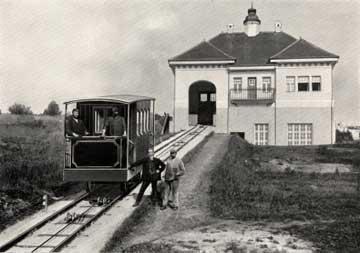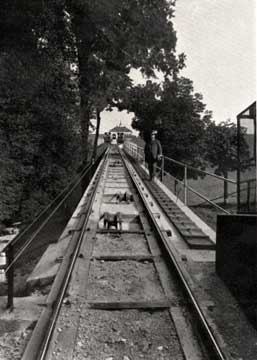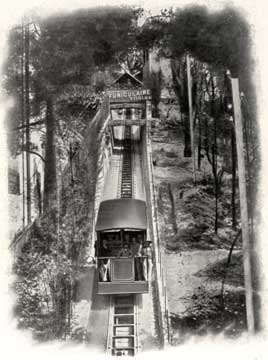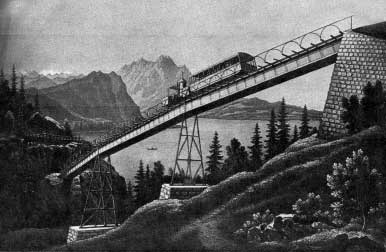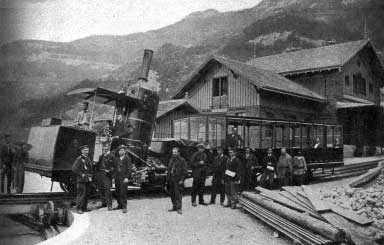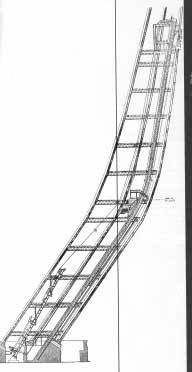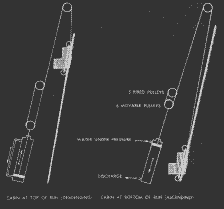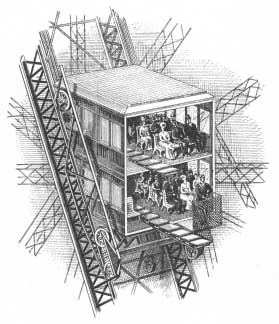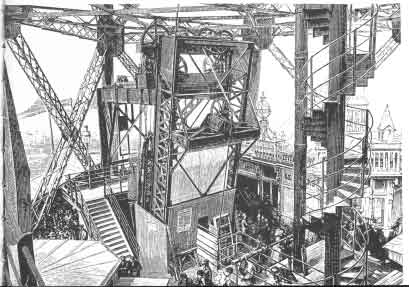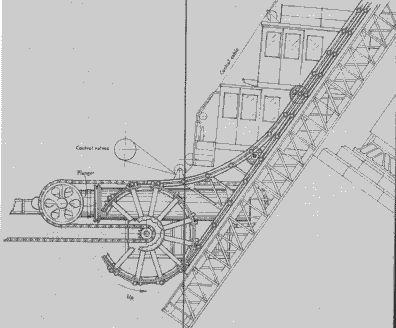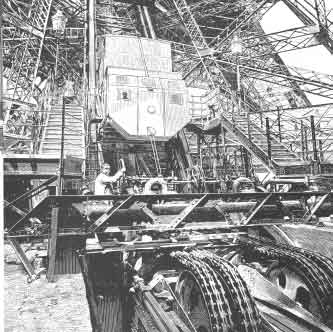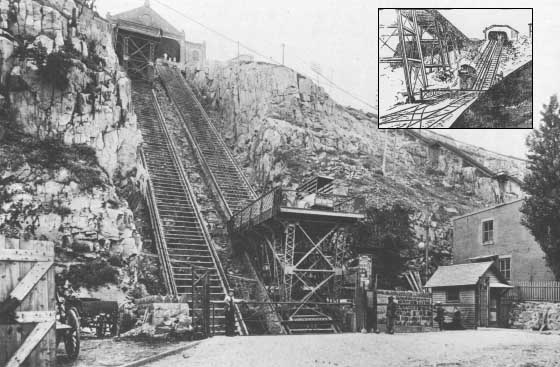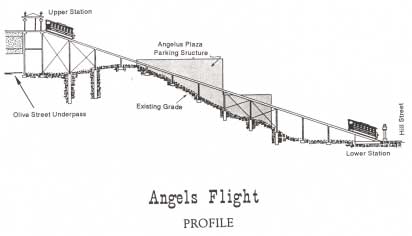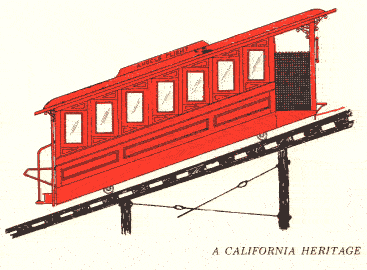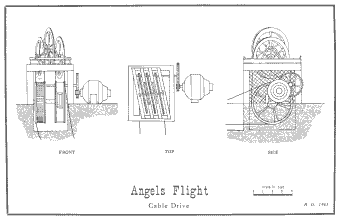|
(f-2-4)
|
|
In 1981, R. Waygood & Company installed the Cliff Lift at West
Hill Hastings. The track was 450 long, a portion of which passed
through a tunnel driven for 363 feet through West Hill. Two 16-passenger
cabins counterbalanced each other, one descending as the other
arose on side-by-side tracks (no turn-out). The drive was by worm
and gearing, powered by a 16 hp Otto Gas Engine. Waygood installed
a somewhat similar lift at Folkstone four years later to carry
passengers between Lees and the beach but it was worked by waterpower,
the angle of the lift being steeper.
(Graphic Source: R. Waygood & Co.)
|
|
 |
(f-2-20, f-2-21)
|
|
Two views of an early Stigler funicular in Germany are shown.
The cars counterbalance each other, passing at a turnout halfway
down the track as shown in the left photo. Note the rollers that
keep the hoist cable from dragging. It is likely that the wheels
on one car had the flange on the outside while the other had them
on the inside.
Graphic Source: Funicolari Elettriche
|
|
 |
(f-2-19)
|
|
Stigler's inclined car taking tourists to the Castello di Hohenaschau
in Bavaria ran on a single track and was powered by electricity.
Graphic Source: Funicolari Elettriche
|
|
 |
(f-2, f-2-18)
|
|
Photos show an electrically operated Stigler funicular in Nice,
France. The deep pit extending under the rails for the length
of the run indicates the car might be counterbalanced by a weight
sliding beneath.
Graphic Source: Funicolari Elettriche
|
|
 |
(f-2-14, f-2-15)
|
|
A steam engine moved 32 passengers over a rack track at the Schnurto
Bel Viaduct of the Vitznau-Rigi Railroad. These two photos of
the Swiss railroad's early days depict the locomotive and passenger
car of the funicular as well as a view of the viaduct span.
(Graphic Source: Ein Jahrhundert)
|
|
 |
(f-2-5)
|
|
Otis Elevator Company installed the longest inclined railway/funicular
in the U.S. at Chattanooga, Tennessee, for service to the top
of Lookout Mountain from where several critical Civil War battlefields
may be viewed. The track is 4,800 feet in length with a 10%
rise at the lower end and 70% grade at the finish. The fifty
passengers per cabin sat at a 35-degree angle. The cars are
counterbalanced and pass at a turnout at midpoint. New electric
equipment replaced the original steam power drives in 1910.
(Graphic Source: The Indicator by Otis)
|
|
 |
(f-2-10, f-2-9, f-2-1, f-2-8)
|
|
Was it a somewhat tilted elevator or a funicular? That will always
be argued as the incline of the elevators installed by Otis Elevator
Company in the Eiffel Tower were so steep (Figure 1). The double-decker
car carried 40 persons at a speed of 400 feet per minute, driven
by the typical indirect, roped-hydraulic of the period (Figure
2). The cylinder of a 30-inch bore, roped 3:1, traveled about
125 feet to the cabin's 377 feet. As the car approached midpoint,
it rounded a corner and climbed more steeply. The car level being
manually maintained by the operator (Figure 3). He also controlled,
via a cable, the hydraulic valve at the pumping equipment on the
lower level. Passengers entered and disembarked each car level
on mechanically extended gangplanks (Figure 4).
(Graphic Source: Elevator World Annual Study - Towers - 1967)
|
|
 |
(f-2-7, f-2-12, f-2-11)
|
|
The French firm of Roux Combalusier and Lepape were given a contract
to accomplish the movement of the same number of passengers in
the other two legs of the Eiffel Tower. Instead of utilizing the
direct-hydraulic piston approach of which the French were the
masters, the firm decided to invent an entirely new technique
of traversing the inclined legs (Figure 1). The system utilized
a string of short, rigid, articulated links that ran in tubes
alongside of the double-decker cars (Figure 2). Two horizontal
plungers rotated sprocket wheels at the bottom, constituting a
mechanism much like the 3:1 roping of the Otis system, but utilizing
chains (Figure 3). It was ultra safe but the friction of the articulated
roller chain links was about five times that of the American system.
The push-pull mechanism was inherently noisy and for the Paris
Exposition of 1900, five year later, the Roux system was replaced
with one similar to that of Otis, built by the French firm of
Five-Lilles. It was a bit too early to take advantage of electric
modernization!
(Graphic Source: Elevator World Annual Study - Towers - 1967)
|
|
 |
(f-2-2)
|
|
 |
(f-2-3, f-2-6, f-2-13)
|
| Construction began on the Angel's
Flight funicular in Los Angeles in 1901, and as electric power had
been brought to the city several years previous, it was used to
drive the hoist equipment with a 50 hp Westinghouse motor. The inclined
elevator climbed Bunker Hill, a fast-growing section of the fast-growing
city. By the stand of the cable cars that were to become popular
on the West Coast, Angel's Flight had a short travel -- 110 feet
-- but what it lacked in length, it made up in capacity, for at
times, the 30-seat cars carried as many as 55 passengers. In 1905,
a trestle was added to straighten out the track and provide an even
33% grade.
(Graphic Source: Angel's Flight by Walt Wheelock)
|
|
|











